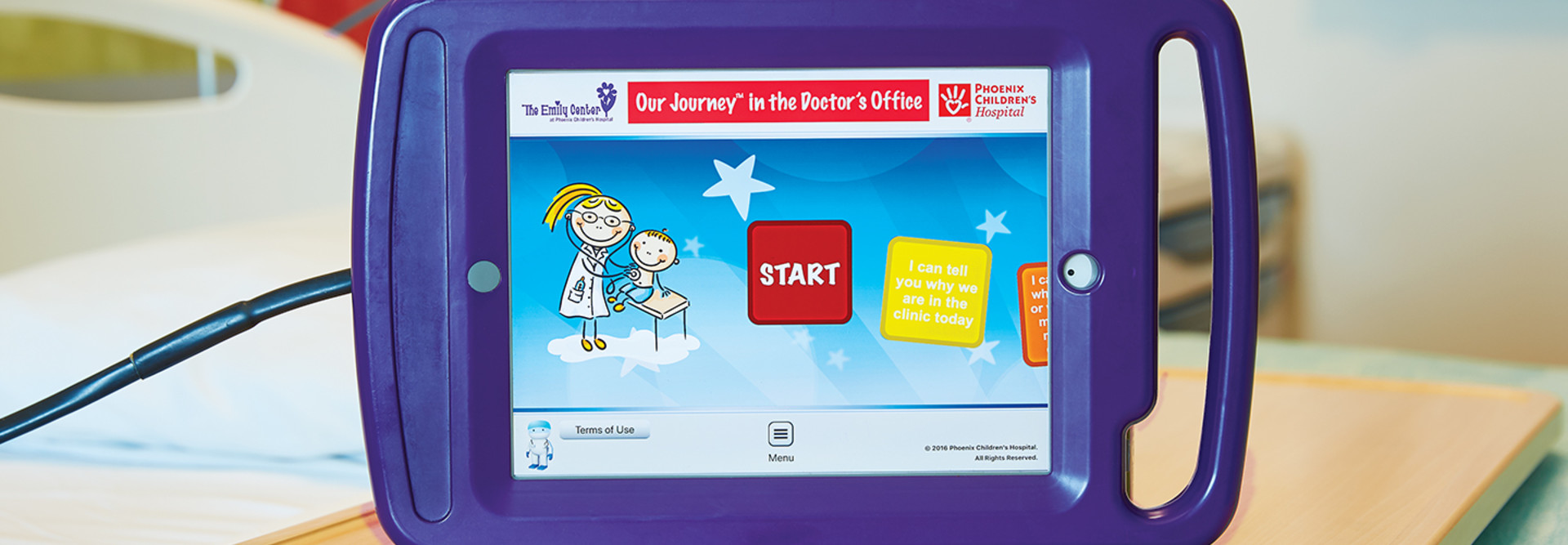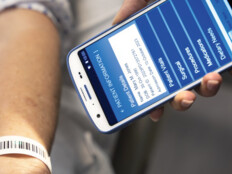Every time young patients are admitted to one of Phoenix Children’s Hospital’s 433 rooms, they’re given an Apple iPad and encouraged to treat it like it was their own computer.
It’s a huge improvement on the stereotypical room with a TV tuned to daytime soaps or 24/7 cable news, Executive Vice President and COO David Higginson says. Besides playing games like “Angry Birds” or “Candy Crush,” patients can log into social media accounts or stream kid-safe movies and educational videos from the hospital’s own Netflix-like server.
Parents can use the same tablets to access medical records and treatment plans via an app called Follow My Health. What’s more, Phoenix Children’s is currently testing a way to let patients order meals via the iPad devices, which would show them only foods their doctors allow them to eat, according to Higginson.
“Research shows that the quality of stay for patients and their potential medical recovery can be greatly influenced by whether they have a distraction device like this,” he says. “We have patients with cystic fibrosis who have to be in isolation over the winter months. Imagine being a teenager locked in a room with no access to social media for a month. It’s miserable.”
MORE FROM HEALTHTECH: Push notifications arm nurses with real-time alerts at Phoenix Children's Hospital.
Phoenix Children's Overcomes Practical Hurdles to Mobility
Mobile-heavy strategies are becoming increasingly common for healthcare organizations looking to modernize the patient care experience. Such efforts involve careful planning, not only to deploy devices to end users, but also to ensure those devices are effectively managed, safe and secure.
Increasing operational costs, pressure to improve clinical outcomes and rising consumer expectations are driving hospitals to prioritize mobility, says Siddharth Shah, an analyst for Frost & Sullivan. “But most healthcare organizations still have a long way to go before they’re truly smart,” he says.
Putting an iPad in each room sounds simple enough, but deployment involved a number of practical challenges that took months to sort out, Higginson says.

Within seven minutes of a patient’s admission to Phoenix Children’s, the iPad in his or her room is wiped and reimaged with the appropriate information, COO David Higginson says. Photo: Steve Craft
For example, the tablets must be both sterile and secure. To that end, every iPad is placed in a special anti-microbial case to prevent one patient from passing infections on to the room’s next occupant. The device is secured to a power source on the wall by a 10-foot cable that’s covered in heat-shrunk, medical-grade plastic.
What’s more, because rooms are assigned based on the patient’s condition and treatment plan, children of various ages and nationalities end up using the same devices. Phoenix Children’s had to make sure the content on each tablet was age- and language-appropriate, that the iPads were secured against computer infections, and that a patient’s personal data or login credentials weren’t passed on to the next person. The hospital uses VMware AirWatch mobile device management and GroundControl software to remotely wipe and reprovision each tablet. “We figured out how to link the devices to each patient’s electronic health record, so within seven minutes of a child being placed in a room, the iPad is wiped and reimaged with an appropriate setup,” Higginson says. “As you can imagine, an iPad for a 3-year-old is a completely different experience than an iPad for a young adult.”
VIDEO: Check out the advantages of putting an iPad in every room at Phoenix Children's Hospital.
Build a Strong Foundation for Healthcare Mobility
While supporting so many devices requires a robust wireless network, the practical considerations outweigh any technical challenges, Higginson says.
“My main advice for other hospitals is, don’t underestimate the physical components. You can’t just hand people an iPad and hope it’s all going to work.” Building an appropriate network infrastructure to support a growing number of mobile devices and ensuring those tools remain secure are also priorities for healthcare organizations, Shah points out.
“Providing enough Wi-Fi coverage, Bluetooth Low Energy and cellular connectivity in all areas of the hospital is important,” he says. “And cybersecurity is the biggest challenge by far. There’s no foolproof solution, but implementing the right controls can help.”
At Virtua Health System, a strong network has been vital for enhancing patient care. Virtua operates three major outpatient centers and nearly 200 care locations throughout southern New Jersey. All of its locations are connected by WAN, and Virtua is currently transitioning to an IP-based phone system, says Senior Vice President and CIO Tom Gordon.
Virtua is also in the middle of a major refresh of its wireless network, something it does every seven years or so, adds Chas Thawley, the organization’s assistant vice president of technology.
“Every other year we do a physical wireless assessment to make sure we still have coverage where we need it,” Thawley says. “And every seven years or so we replace the actual wireless infrastructure to make it denser and more reliable. Hardware gets better, faster and cheaper every couple of years, and we want to make sure we continue to keep it working great.”
But the range, as well as the scope and age, of the connected devices on Virtua’s network is huge — and even the latest and greatest technologies are often insecure. That’s why the health system uses network segmentation to quarantine sensitive equipment, limiting the potential damage if a device is compromised. In addition, the organization has centralized procurement, so that every device must pass muster with IT before it’s allowed to join the network. If the device connects to the internet by default, they’ll turn that feature off or isolate it from the network.
“There’s always a balance between security and innovation, especially if it’s an innovative device that can help save a life,” Gordon says.

Seniors Tap Tablets for Pain Management, Entertainment
In addition to improving the patient experience, mobile devices are being deployed to help reduce patient suffering. At Southern Hills Hospital and Medical Center in Las Vegas, doctors use Samsung tablets running AI software to help patients manage pain and reduce their dependence on opioids.
Patients wear a special headband that measures their brainwaves and transmits the data to software running on the tablet, which performs a full-spectrum brain analysis, drawing on the largest database on pain outside of the National Institutes of Health. When it detects a pattern that indicates pain, discomfort or nausea, the software delivers personalized diversionary content.
The tablets are stored in carts that charge and sanitize them between uses. They don’t capture personally identifiable information and are protected by Samsung’s Knox security toolkit.
The pain management software has been used by everyone from moms in delivery to oncology patients undergoing chemotherapy. Seniors play cognitive games on the tablets to keep their brains sharp, while patients who have trouble sleeping in hospitals use music apps to help them nod off.
“This has greatly enhanced the patient experience in our hospital emergency department,” says Kathy Millhiser, director of emergency services at Southern Hills. “We understand how vulnerable our patients can feel when they are in pain and come to the hospital for care.












